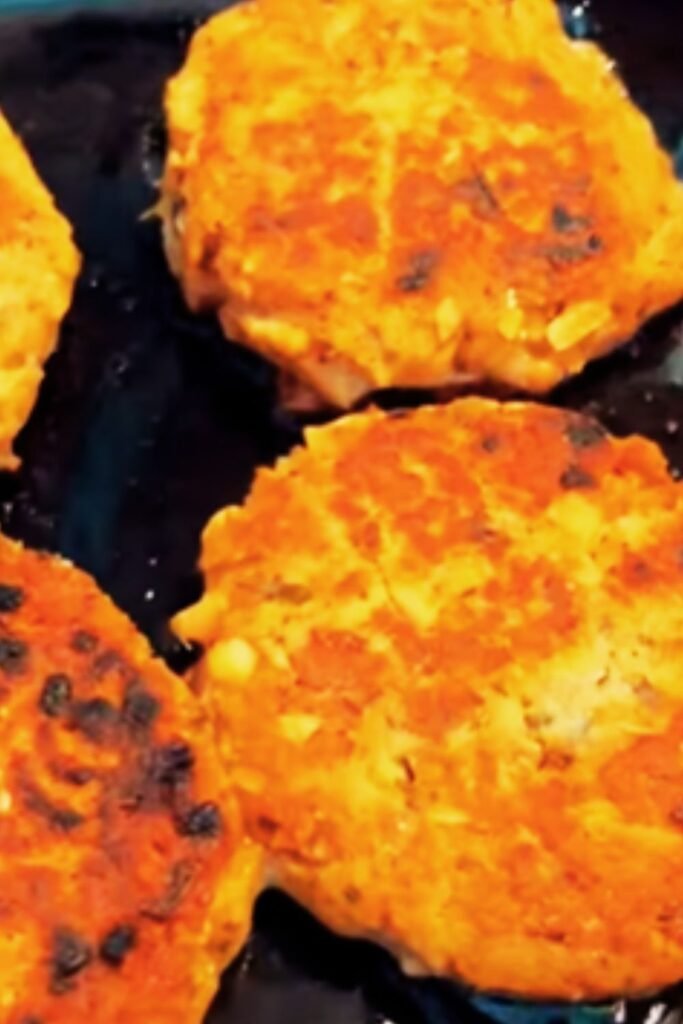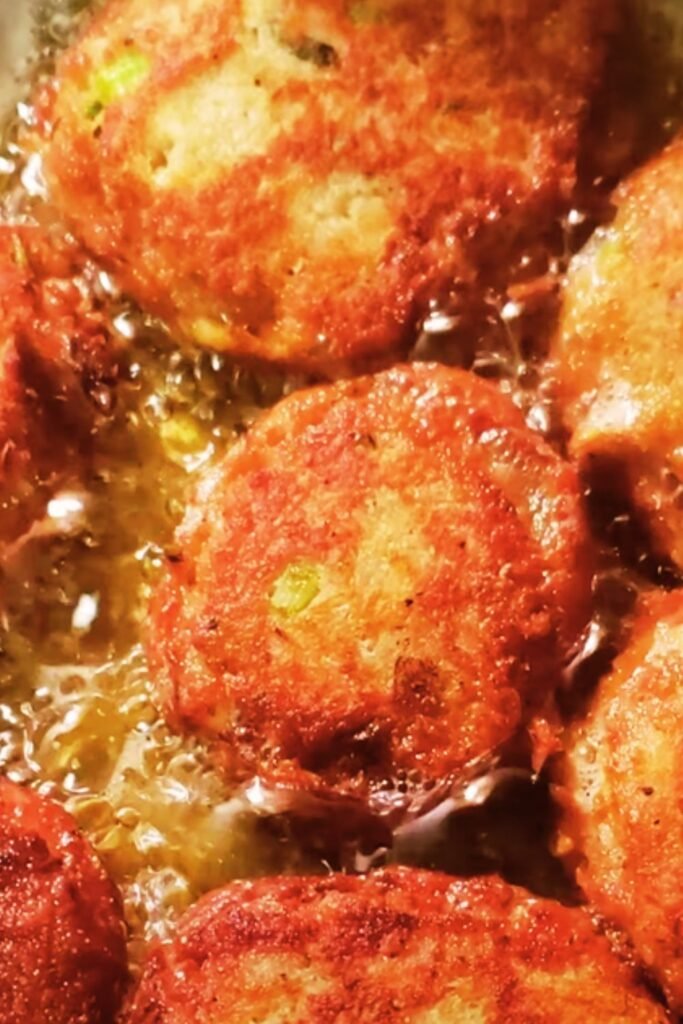There’s something magical about the aroma of salmon patties sizzling in a cast-iron skillet that instantly transports me back to my grandmother’s kitchen. I remember standing on a wooden step stool, watching her expertly form those golden-brown patties with her weathered hands, the same hands that had been making this recipe for decades. Old fashioned salmon patties aren’t just food – they’re edible memories that connect us to simpler times when families gathered around dinner tables and shared stories over hearty, homemade meals.
These crispy-on-the-outside, tender-on-the-inside patties have been a staple in American households since the early 1900s, born out of necessity during times when fresh fish was expensive or hard to come by. Canned salmon became the hero ingredient that allowed families to enjoy nutritious, flavorful meals without breaking the bank. What started as a practical solution evolved into a beloved comfort food that has graced dinner tables for generations.
Understanding the Foundation: What Makes Perfect Salmon Patties
Canned Salmon: The star of the show, typically pink or red salmon packed in water or oil. The quality of your canned salmon directly impacts the final result.
Binding Agents: Usually eggs and breadcrumbs or crackers that hold everything together while adding texture and moisture.
Aromatics: Onions, garlic, and fresh herbs that infuse the patties with depth and complexity.
Seasonings: Salt, pepper, and various spices that enhance the natural salmon flavor without overpowering it.
Cooking Fat: Traditionally butter or oil for achieving that coveted golden crust.
The beauty of salmon patties lies in their simplicity and versatility. Unlike fresh salmon preparations that require precise timing and temperature control, these forgiving patties allow for creativity and personal touches that make each family’s version unique.
The Science Behind Perfect Salmon Patties
Creating exceptional salmon patties isn’t just about following a recipe – it’s about understanding the science that makes them work. The proteins in the salmon and eggs create a network that binds the mixture together, while the starches in breadcrumbs absorb moisture and provide structure. When heat is applied, the Maillard reaction creates those beautiful golden-brown surfaces that deliver incredible flavor and satisfying texture contrasts.
I’ve discovered that the moisture content is crucial. Too wet, and your patties will fall apart in the pan. Too dry, and they’ll be dense and crumbly. The perfect balance creates patties that hold together beautifully while remaining moist and tender inside.
My Time-Tested Old Fashioned Salmon Patties Recipe
Ingredients (Serves 4-6)
| Ingredient | Amount | Purpose | Substitution Options |
|---|---|---|---|
| Canned salmon | 2 (14.75 oz) cans | Main protein | Fresh cooked salmon (2 cups flaked) |
| Large eggs | 2 | Binding agent | Flax eggs (vegan option) |
| Fine breadcrumbs | 1/2 cup | Texture and binding | Crushed crackers, panko |
| Yellow onion | 1 medium, finely diced | Flavor base | Green onions, shallots |
| Fresh parsley | 2 tablespoons, chopped | Freshness | Dill, cilantro |
| Lemon juice | 1 tablespoon | Brightness | Lime juice, white vinegar |
| Garlic powder | 1 teaspoon | Depth | Fresh minced garlic |
| Salt | 1 teaspoon | Seasoning | Sea salt, kosher salt |
| Black pepper | 1/2 teaspoon | Heat | White pepper |
| Paprika | 1/2 teaspoon | Color and mild spice | Cayenne (less amount) |
| Butter | 2-3 tablespoons | Cooking fat | Vegetable oil, olive oil |

Step-by-Step Instructions
Preparation Phase
- Drain the canned salmon thoroughly and transfer to a large mixing bowl
- Remove any large bones and skin pieces, though small soft bones add calcium and can be left in
- Flake the salmon gently with a fork, maintaining some texture rather than creating a paste
Building the Mixture 4. Add the beaten eggs to the salmon, mixing gently to coat all pieces 5. Incorporate the finely diced onion, ensuring even distribution throughout the mixture 6. Sprinkle in the breadcrumbs gradually, mixing after each addition to prevent clumping 7. Add parsley, lemon juice, and all seasonings, folding everything together with a light hand
The Crucial Rest Period 8. Cover the mixture and refrigerate for 30 minutes to allow the breadcrumbs to hydrate and flavors to meld 9. This resting period is essential – it prevents the patties from falling apart during cooking
Forming the Patties 10. With damp hands, scoop about 1/3 cup of mixture and gently form into patties about 3 inches in diameter 11. Don’t compress too firmly – you want them cohesive but not dense 12. Place formed patties on a plate and chill for another 15 minutes if time allows
Cooking to Perfection 13. Heat butter in a large skillet over medium heat until it begins to foam 14. Carefully place patties in the skillet, leaving space between each one 15. Cook for 4-5 minutes on the first side until golden brown and crispy 16. Flip gently and cook for another 3-4 minutes until the second side matches
Nutritional Benefits That Make You Feel Good
| Nutrient | Amount per Serving | % Daily Value | Health Benefits |
|---|---|---|---|
| Protein | 28g | 56% | Muscle building and repair |
| Omega-3 fatty acids | 1.2g | N/A | Heart and brain health |
| Calcium | 280mg | 28% | Bone strength |
| Vitamin D | 150 IU | 38% | Immune function |
| Selenium | 32mcg | 58% | Antioxidant properties |
| Vitamin B12 | 2.8mcg | 117% | Nerve function |
| Iron | 1.8mg | 10% | Oxygen transport |
The nutritional profile of salmon patties makes them a powerhouse meal that satisfies hunger while nourishing the body. The high-quality protein provides all essential amino acids, while the omega-3 fatty acids support cardiovascular health and cognitive function.

Mastering the Variables: Tips for Consistent Success
Texture Preferences: Some families prefer chunkier patties with larger salmon pieces, while others like them finely flaked. I recommend finding your family’s preference and sticking with it consistently.
Moisture Management: If your mixture seems too wet, add breadcrumbs a tablespoon at a time. If too dry, add a beaten egg or a splash of milk.
Size Consistency: Using an ice cream scoop or measuring cup ensures uniform patties that cook evenly.
Temperature Control: Medium heat is crucial. Too high, and the outside burns before the inside sets. Too low, and you won’t get proper browning.
Oil vs. Butter: I prefer butter for flavor, but oil works well too. A combination of both gives you buttery taste with higher smoke point.
Regional Variations I’ve Discovered
During my travels and conversations with home cooks across the country, I’ve encountered fascinating regional variations that reflect local tastes and available ingredients.
Southern Style: Often includes cornmeal in the coating and is served with grits and collard greens. Some cooks add a touch of hot sauce directly to the mixture.
Pacific Northwest Version: Incorporates fresh dill and sometimes capers, reflecting the region’s Scandinavian influences.
New England Approach: Features Old Bay seasoning and is commonly served with coleslaw and baked beans.
Midwest Tradition: Tends to be simpler, focusing on the salmon flavor with minimal seasonings, often served with mashed potatoes.
Serving Suggestions That Complete the Experience
| Accompaniment | Why It Works | Preparation Tip |
|---|---|---|
| Creamy mashed potatoes | Classic comfort combination | Add a touch of horseradish |
| Coleslaw | Cool, crunchy contrast | Make ahead for better flavor |
| Green beans | Fresh vegetable balance | Steam until crisp-tender |
| Cornbread | Southern tradition | Serve warm with honey butter |
| Tartar sauce | Traditional fish pairing | Homemade is worth the effort |
| Lemon wedges | Brightens rich flavors | Room temperature for more juice |
The key to perfect accompaniments is balancing textures and temperatures. I love serving hot, crispy patties with cool, creamy sides and something acidic to cut through the richness.

Storage and Reheating: Making the Most of Leftovers
Refrigeration: Cooked salmon patties keep well in the refrigerator for up to three days when stored in an airtight container.
Freezing: Both uncooked and cooked patties freeze beautifully for up to three months. Layer between parchment paper in freezer containers.
Reheating Methods: The oven is my preferred method for maintaining crispiness. Heat at 350°F for 8-10 minutes, flipping halfway through.
Creative Leftover Uses: Crumble cold patties over salads, use in sandwiches, or incorporate into pasta dishes for quick weeknight meals.
Troubleshooting Common Issues
Patties Fall Apart: Usually indicates too much moisture or insufficient binding. Add more breadcrumbs or an extra egg.
Dense Texture: Often caused by over-mixing or pressing too firmly when forming. Handle gently and don’t compact.
Bland Flavor: Under-seasoning is common with canned salmon. Taste the mixture before cooking and adjust accordingly.
Greasy Results: Temperature too low or too much oil. Drain on paper towels and adjust heat for next batch.
Making It Your Own: Customization Ideas
The beauty of salmon patties lies in their adaptability to personal tastes and dietary needs. I encourage experimentation while respecting the fundamental structure that makes them work.
Herb Variations: Try fresh dill, chives, or cilantro instead of parsley for different flavor profiles.
Spice Additions: A pinch of cayenne, some curry powder, or even Everything Bagel seasoning can create exciting variations.
Vegetable Additions: Finely diced bell peppers, celery, or jalapeños add crunch and flavor complexity.
Gluten-Free Options: Crushed pork rinds, almond flour, or gluten-free breadcrumbs work perfectly for those with dietary restrictions.
The Economics of Home Cooking
One aspect I particularly appreciate about salmon patties is their economic efficiency. A single batch using two cans of salmon costs approximately $8-10 and feeds a family of four generously. Compare this to restaurant prices or fresh salmon costs, and the savings become significant.
The versatility also contributes to their value – they work equally well as a main course, sandwich filling, or salad topper, maximizing your ingredient investment.
Frequently Asked Questions
Q: Can I use fresh salmon instead of canned? A: Absolutely! Use about 2 cups of cooked, flaked salmon. Season it well since fresh salmon is milder than canned.
Q: Why do my patties always fall apart when I flip them? A: This usually happens when the mixture is too wet or hasn’t had enough time to set. Try chilling the formed patties before cooking and ensure your pan isn’t overcrowded.
Q: Can I bake these instead of pan-frying? A: Yes, bake at 400°F for 15-20 minutes, flipping once. You won’t get the same crispy crust, but they’ll be healthier and still delicious.
Q: How can I make them less fishy-tasting? A: Add more lemon juice, use pink salmon instead of red, and ensure you’re draining the salmon thoroughly. Fresh herbs also help balance the fish flavor.
Q: What’s the best way to reheat leftover patties? A: The oven at 350°F for 8-10 minutes gives the best results, maintaining both moisture and crispiness.
Q: Can I make these ahead of time? A: Yes! Form the patties and refrigerate up to 24 hours before cooking, or freeze for longer storage.
Q: Are salmon patties healthy? A: Very! They’re high in protein, omega-3 fatty acids, and various vitamins and minerals while being relatively low in calories.
Q: Why do some recipes call for crackers instead of breadcrumbs? A: Crackers add a slightly different texture and flavor. Saltines are traditional, but any crisp cracker works well.
Q: Can I make mini patties for appetizers? A: Definitely! Form smaller patties and reduce cooking time accordingly. They make excellent party appetizers with a dollop of tartar sauce.
Q: What should I do if I don’t have eggs? A: Try using mayonnaise (about 2 tablespoons) or make flax eggs as a binding alternative.
These old fashioned salmon patties represent more than just a recipe – they’re a connection to our culinary heritage and a testament to the ingenuity of home cooks who transformed simple ingredients into something extraordinary. Whether you’re continuing a family tradition or starting a new one, these golden, crispy patties will undoubtedly become a cherished part of your cooking repertoire.
The next time you’re looking for a comforting, nutritious meal that brings people together around the dinner table, remember that sometimes the most satisfying dishes are the ones that have been lovingly passed down through generations. In a world of complicated cooking techniques and exotic ingredients, there’s profound beauty in the simplicity and reliability of a perfectly made salmon patty.